
1
Mumbai University
Engineering
Mechanics
May 2019
Question Paper
Solution

2
Q1. Attempt Any Four:
(a) Find the resultant of forces as shown in fig. (05 marks)
Solution:
2
2
22
F (7) (10cos(36 )) (10cos(72 )) ( 3cos(72 )) kN
F 17.25 kN
F (10sin(36 )) (10sin(72 )) (3sin(72 )) kN
F 18.24 kN
Resultant= F F kN
= 17.25 18.24 kN
=25.10 kN
x
x
y
y
xy
11
Resultant=25.10 kN
F
18.24
=tan tan 46.6
F 17.25
46.6
y
x
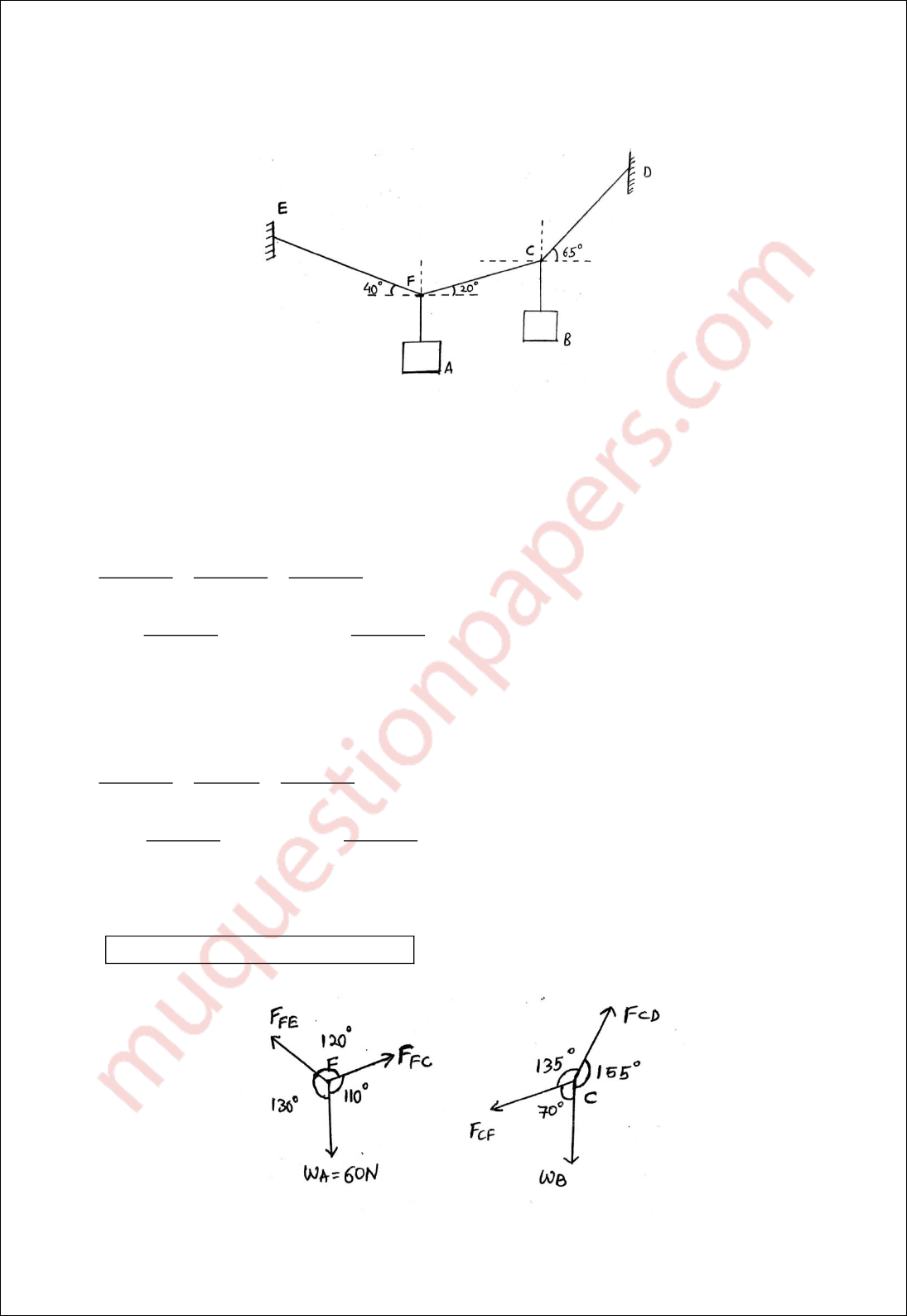
3
(b) If the cords suspended the two buckets in equilibrium position shown in Fig.
Determine weight of bucket B if bucket A has a weight of 60 N. (05 marks)
Solution:
A
FC
A FE
A
FC
FC
B
W 60 N ... Given
Applying Lami's Theorem at point F,
F
WF
sin(120 ) sin(130 ) sin(110 )
W
60
F sin(130 ) N sin(130 ) N
sin(120 ) sin(120 )
F 53.07 N
Applying Lami's Theorem at point C,
W
sin(13
CD CF
CF
B
B
FF
5 ) sin(70 ) sin(155 )
F
53.07
W sin(135 ) N= sin(135 ) N
sin(155 ) sin(155 )
W 88.79 N
The weight of the bucket B = 88.79 N
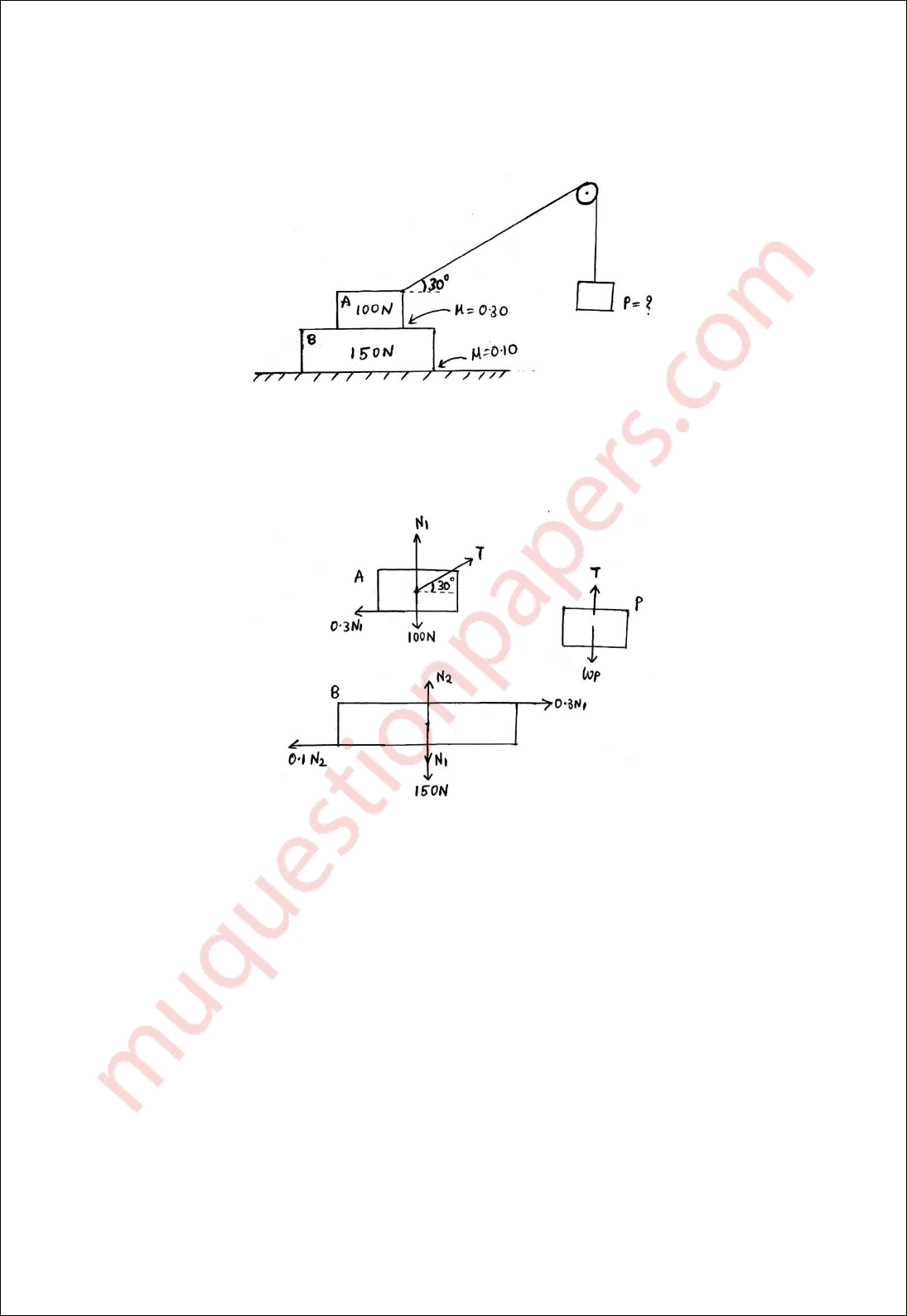
4
(c) Two blocks A=100 N and B=150 N are resting on the ground as shown in fig. Find
the minimum weight P in the pan so that body A starts. Assume pulley to be mass less
and frictionless. (05 marks)
Solution:
The FBD is shown below,
Let the tension in the string be ‘T’ N
Let the normal force between the two blocks A and B be
1
N
N
Let the normal force between block B and ground be
2
N
N
For block to just start to move, the friction force acting on block A will be backwards
And on block B the same force will be forwards.
The friction force between block B and ground will be backwards on block B.
x
12
Applying equilibrium conditions on Block B,
F0
(0.3N ) (0.1N ) 0 ...(1)

5
y
21
12
12
F0
N 150 N 0
N +N =150 ...(2)
From (1) and (2)
N 75 N and N = 225 N
x
1
P
Applying equilibrium conditions on Block A,
F0
(Tcos(30 ))-(0.3N ) 0
(Tcos(30 ))-(0.3 75 ) 0
T= 25.98 N
On block P,
WT
The minimum weight P in the pan so that block A just starts = 25.98 N
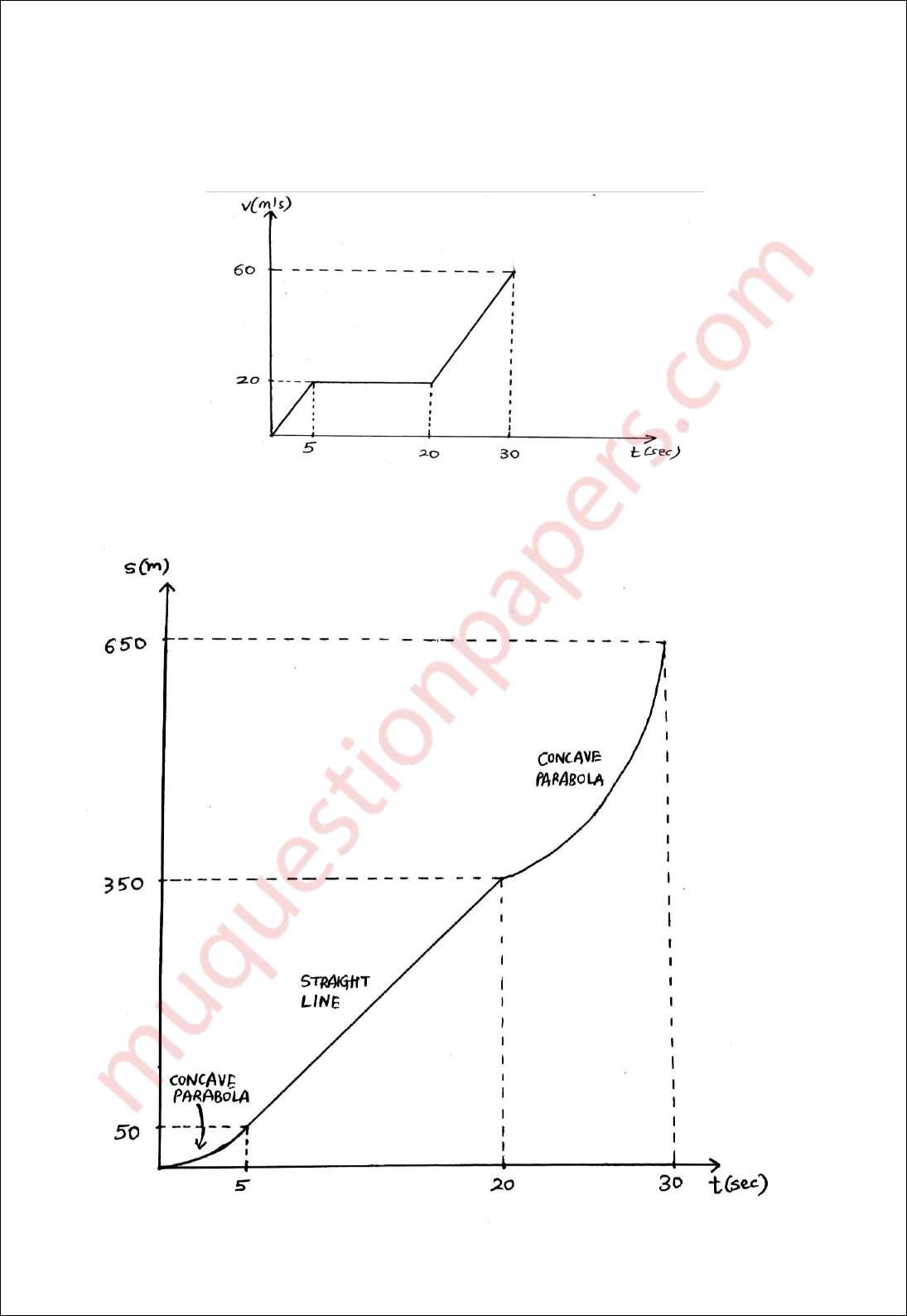
6
(d) The motion of jet plane while travelling along a runway is defined by the v-t graph
as shown in Fig. Construct the s-t graph for the motion. The plane starts from rest.
(05 marks)
Solution: The required graph is:

7
Explanation :
For S-T graph
.ds v dt
=Area under the graph under time interval
Since the object is at rest initially,
0
S 0 m
For time 0 to 5 seconds
5
20
5
30
20
S
5
00
55
S
20
S5
20 5 20
S
30
S 20
1
. Area under graph from 0 to 5 seconds= 5 20 m
2
S 0 50 m S 50 m
. Area under graph from 5 to 20 seconds= 20 5 20 m
S S 300 m S 350 m
. Area under
ds v dt
ds v dt
ds v dt
30 20 30
1
graph from 20 to 30 seconds= 30 20 20 + 30 20 60 20 m
2
S S 400 m S 750 m
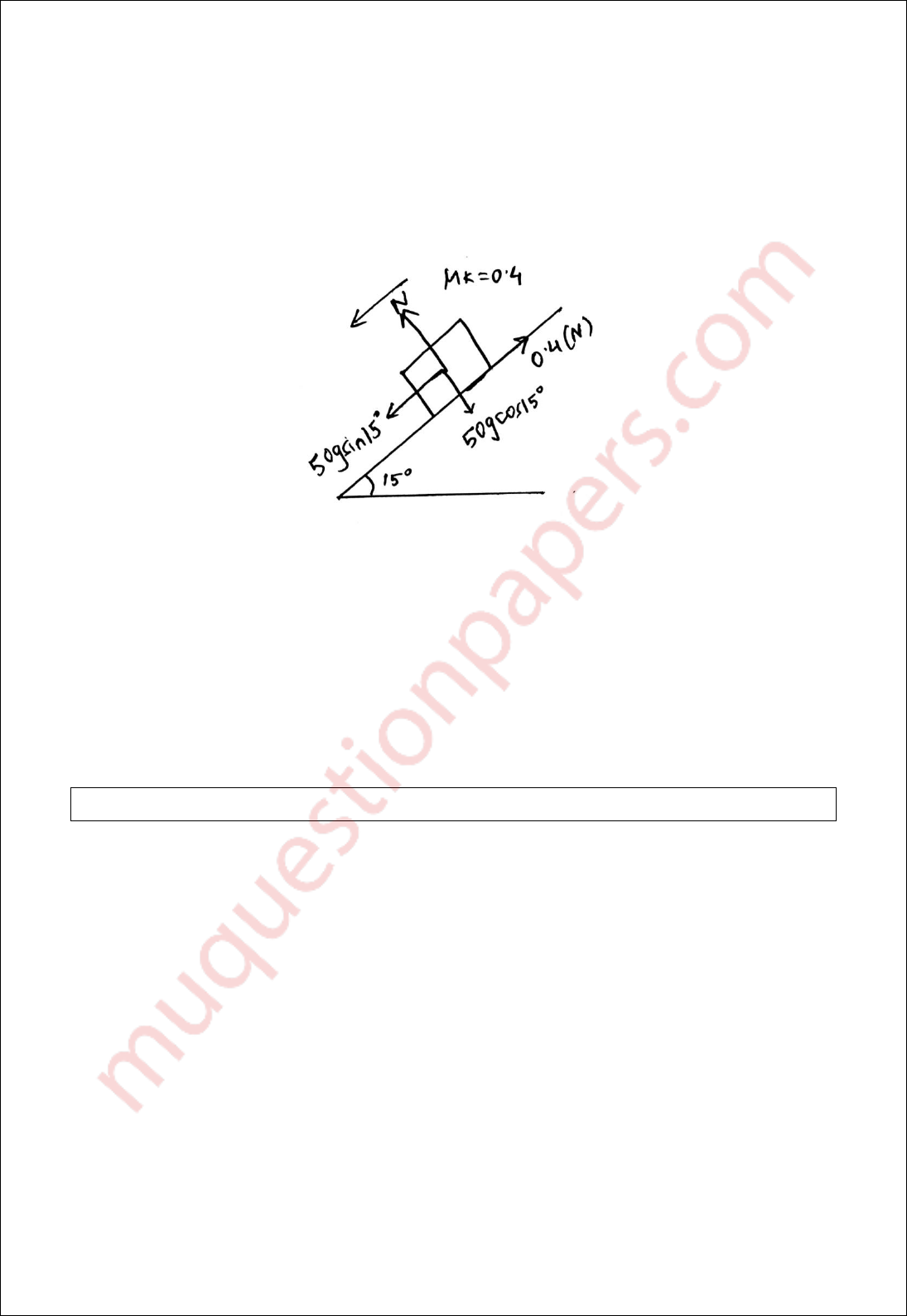
8
(e) A 50 kg block is kept on the top of a
15
slopping surface is pushed down the plane
with an initial velocity of 20 m/s. If
0.4
k
, determine the acceleration of the block.
(05 marks)
Solution: The FBD is,
2
On the block,
=50gsin(15 )=50(9.8)sin(15 )
=126.82 N
50gsin(15 ) 0.4( ) 50( ) where is acceleration of the block
50 9.8 sin(15 ) 0.4 126.82 50( )
1.52 m/s
N
N
N a a
a
a
The acceleration of the block =
2
1.52 m/s
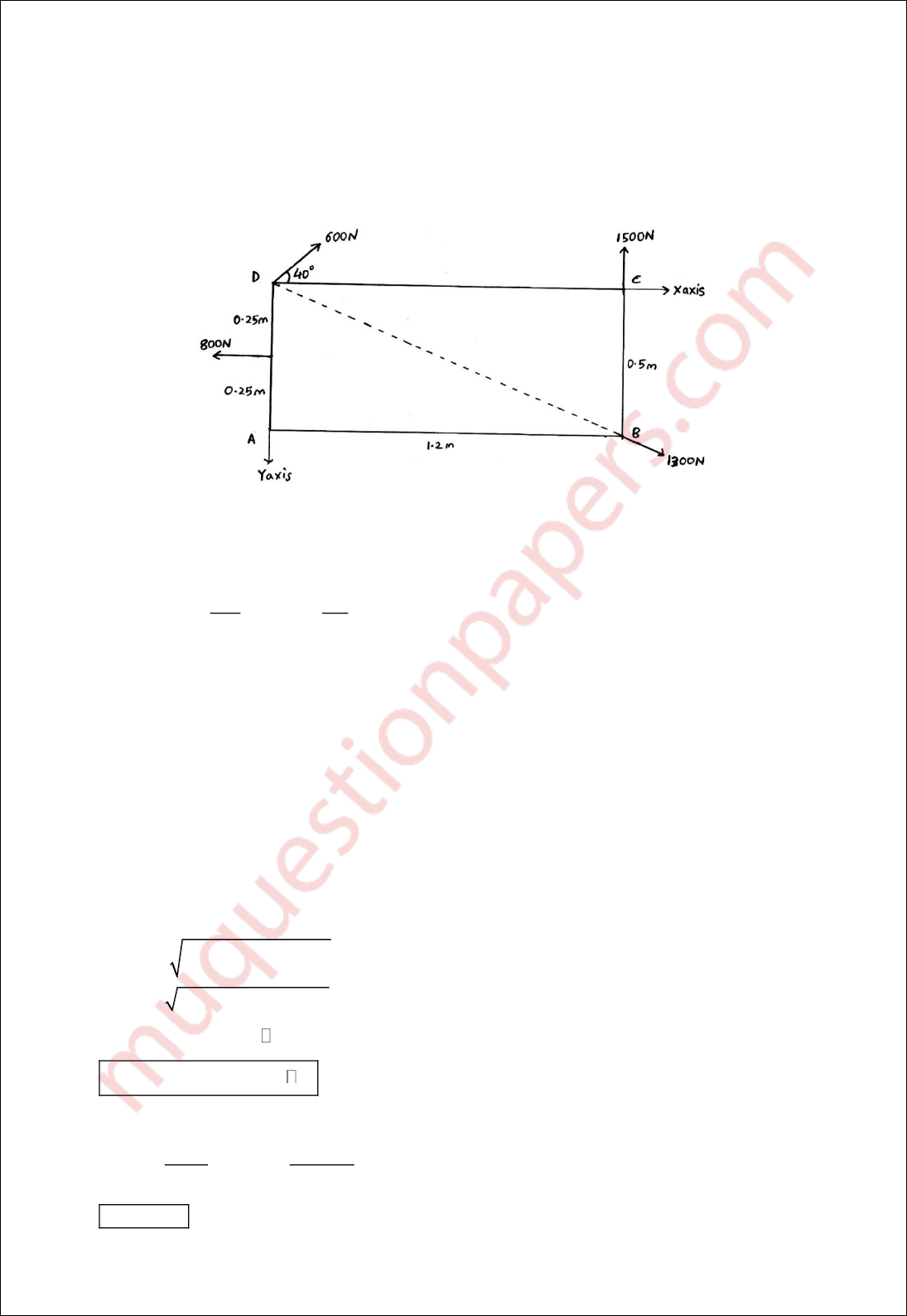
9
Q2. Attempt:
(a) Four forces acting on a rectangle in the same plane as shown in fig. below. Find
magnitude and direction of resultant force. Also find intersection of line of action of
resultant with X and Y axes, assuming D as origin. (06 marks)
Solution:
11
x
x
y
Finding ABD
AD 0.5
ABD tan tan
AB 1.2
ABD 22.62
The angle made by 1300 N force with horizontal is 22.62
F 1300cos(22.62 ) 600cos(40 ) 800 N
F 859.63 N
F 600sin(40 ) 1500 1300sin(
y
2
2
xy
22
y
11
x
22.62 ) N
F 1385.67 N
Resultant= F F N
= 859.63 1385.67 N
=1630.66 N
Resultant=1630.66 N
F
1385.67
tan tan 58.19
F 859.63
58.19

10
0
0
0
y
0
x
M (1500)(1.2) (1300cos(22.62 )(0.5) 1300sin(22.62 )(1.2) (800)(0.25)
M 1600 N-m
M
1600
X= 1.15 m
F 1385.67
M
1600
Y= 1.86 m
F 859.63
X=1.15 m and Y=1.86 m
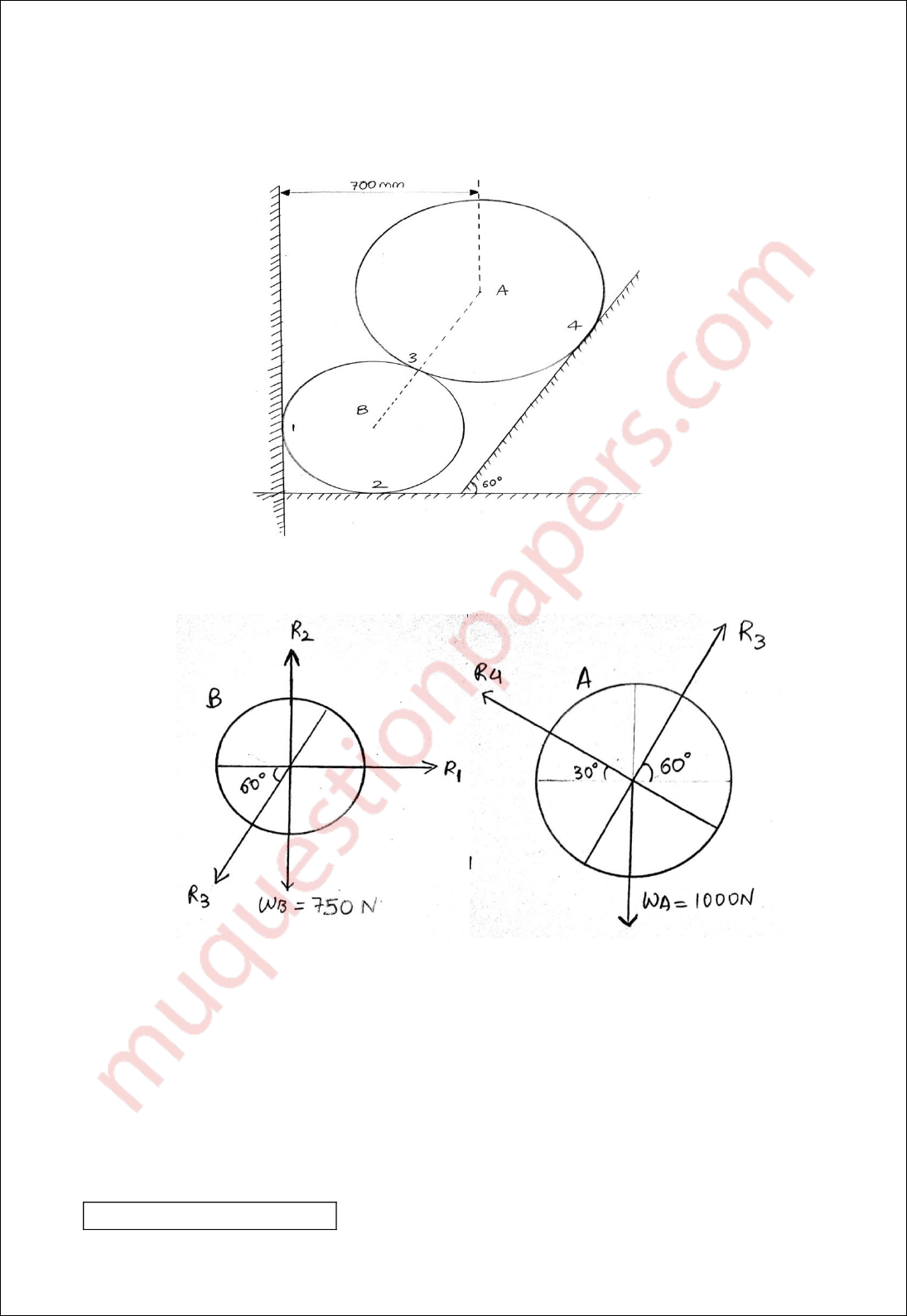
11
(b) Two spheres A and B of weight 1000 N and 750 N respectively are kept as shown in
fig. Determine the reactions at all contact points 1, 2, 3 and 4. Radius of A=400 mm and
B=300 mm. (08 marks)
Solution:
x
34
y
34
34
34
Applying equilibrium conditions on ball A
F0
R cos(60 ) R cos(30 ) 0 ...(1)
F0
R sin(60 ) R sin(30 ) 1000 0
R sin(60 ) R sin(30 ) 1000 ...(2)
From (1) and (2)
R 866.03 N and R 500 N

12
x
13
13
1
y
23
2
2
Applying equilibrium conditions on ball B
F0
R R cos(60 )=0
R R cos(60 ) (866.03)cos(60 )
R 433.02 N
F0
R R sin(60 ) 750 0
R (866.03)sin(60 ) 750 0
R 1500 N
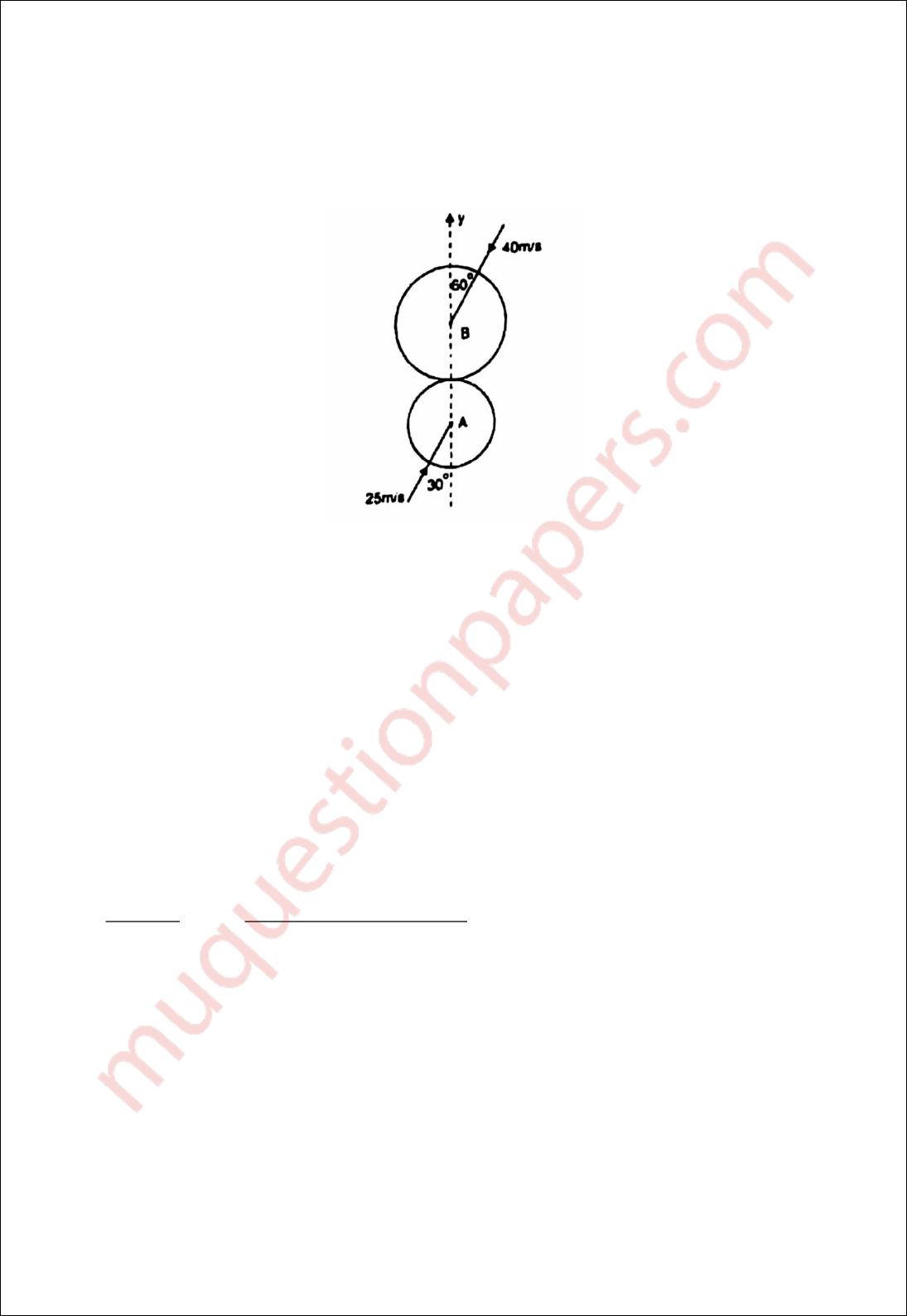
13
(c) Two smooth balls A (mass 3 kg) and B (mass 4 kg) are moving with velocities 25 m/s
and 40 m/s respectively. Before impact, the directions of velocity of two balls are 30
and 60
with the line joining the centres as shown in Fig. If e=0.8, find magnitude and
direction of velocities of the balls after impact. (06 marks)
Solution:
AB
AB
A
B
Ax
Let u and u be the initial velocities of balls A and B respectively,
Let v and v be the final velocities of balls A and B respectively,
u 25sin(30 ) 25cos(30 )
u 40sin(60 ) 40cos(30 )
Let v
ij
ij
Ay
Bx By
A
and v be the x and y components of velocity of ball A resp,
Let v and v be the x and y components of velocity of ball B resp,
Applying Law of conservation of linear momentum along y direction,
mu
Ay B By A Ay B By
Ay By
By Ay By Ay
Ay By
Ay By
Ay
m u m v m v
3(25cos(30 )) 4( 40cos(60 )) 3v 4v ...(1)
v v v v
e= 0.8
u u 25cos(30 ) ( 40cos(60 ))
0.8 25cos(30 ) ( 40cos(60 )) v v ...(2)
From (1) and (2)
v 21.19 m/s
By
Ax Bx
v 12.13 m/s
The velocities along the perpendicular to line of action remain unchanged,
v 25sin(30 ) 12.5 m/s and v 40sin(60 ) 34.64 m/s

14
A
B
v 12.5 21.19 m/s
v 34.64 12.13 m/s
ij
ij
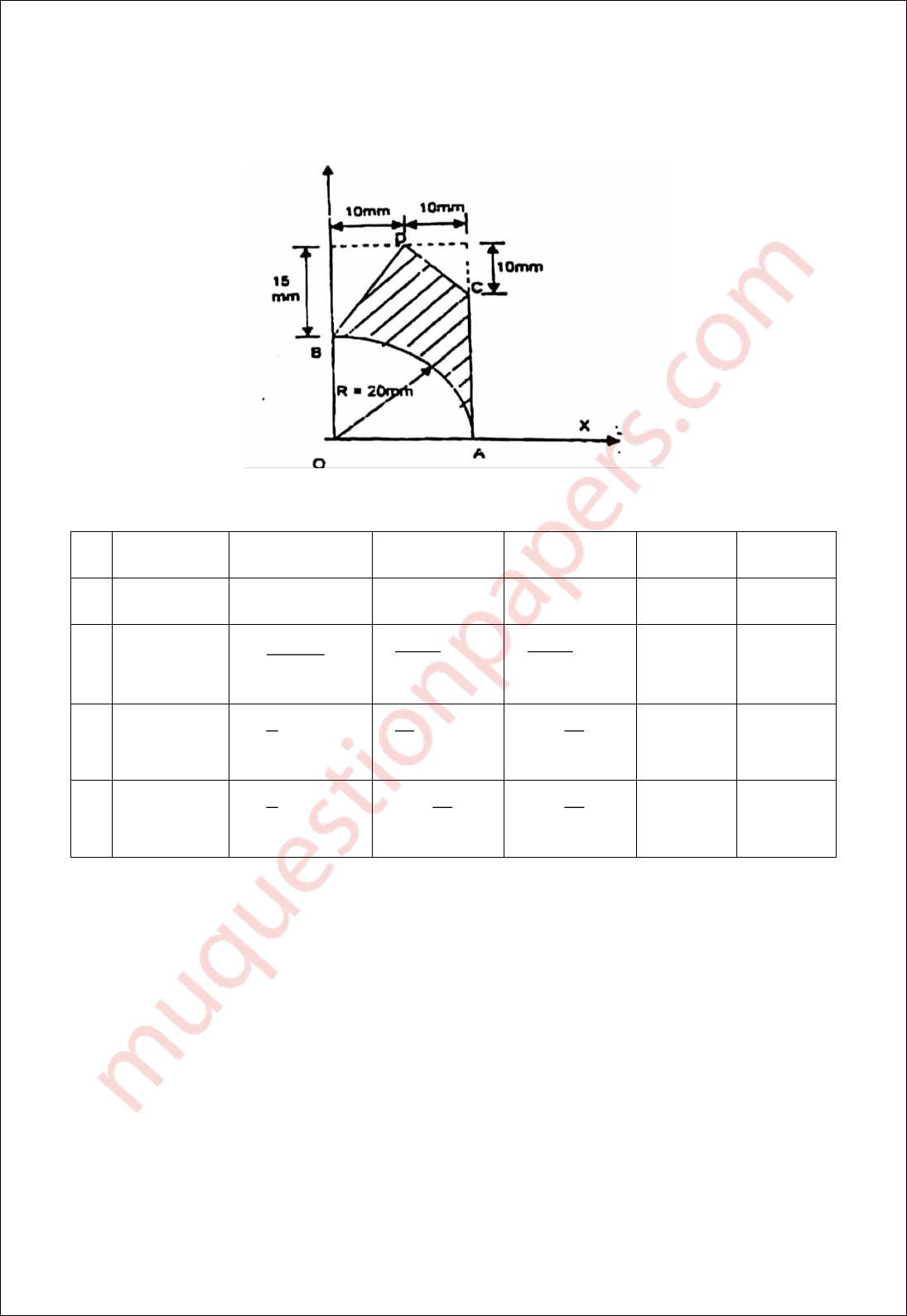
15
Q3. Attempt:
(a) Find the centroid of shaded area as shown in fig. (08 marks)
Solution:
Shape
Area(in mm
2
)
X-
Coordinate
Y-
Coordinate
AX
AY
1.
Rectangle
=(35)(20)
=700
=10
=17.5
=7000
=12250
2.
Quarter
Circle
=
2
(20)
4
=
314.16
=
4(20)
3
=8.49
=
4(20)
3
=8.49
=
2667.22
=
2667.22
3.
Triangle
(ht=15 mm,
bs=10 mm)
=
1
(10)(15)
2
=
75
=
10
3
=3.33
=
15
35
3
=30
=
250
=
2250
4.
Triangle
(ht=10 mm,
bs=10 mm)
=
1
(10)(10)
2
=
50
=
10
20
3
=16.67
=
10
35
3
=31.67
=
833.5
=
1583.5
2
2
2
2
2
2
A 700 314.16 75 50 mm
A 260.84 mm
AX 7000 2667.22 250 833.5 mm
AX 3249.28 mm
AY 12250 2667.22 2250 1583.5 mm
AY 5749.28 mm

16
AX
3249.28
X= 12.46 mm
A 260.84
AY
5749.28
Y= 22.04 mm
A 260.84
Centroid is,
X=12.46 mm and Y=22.04 mm
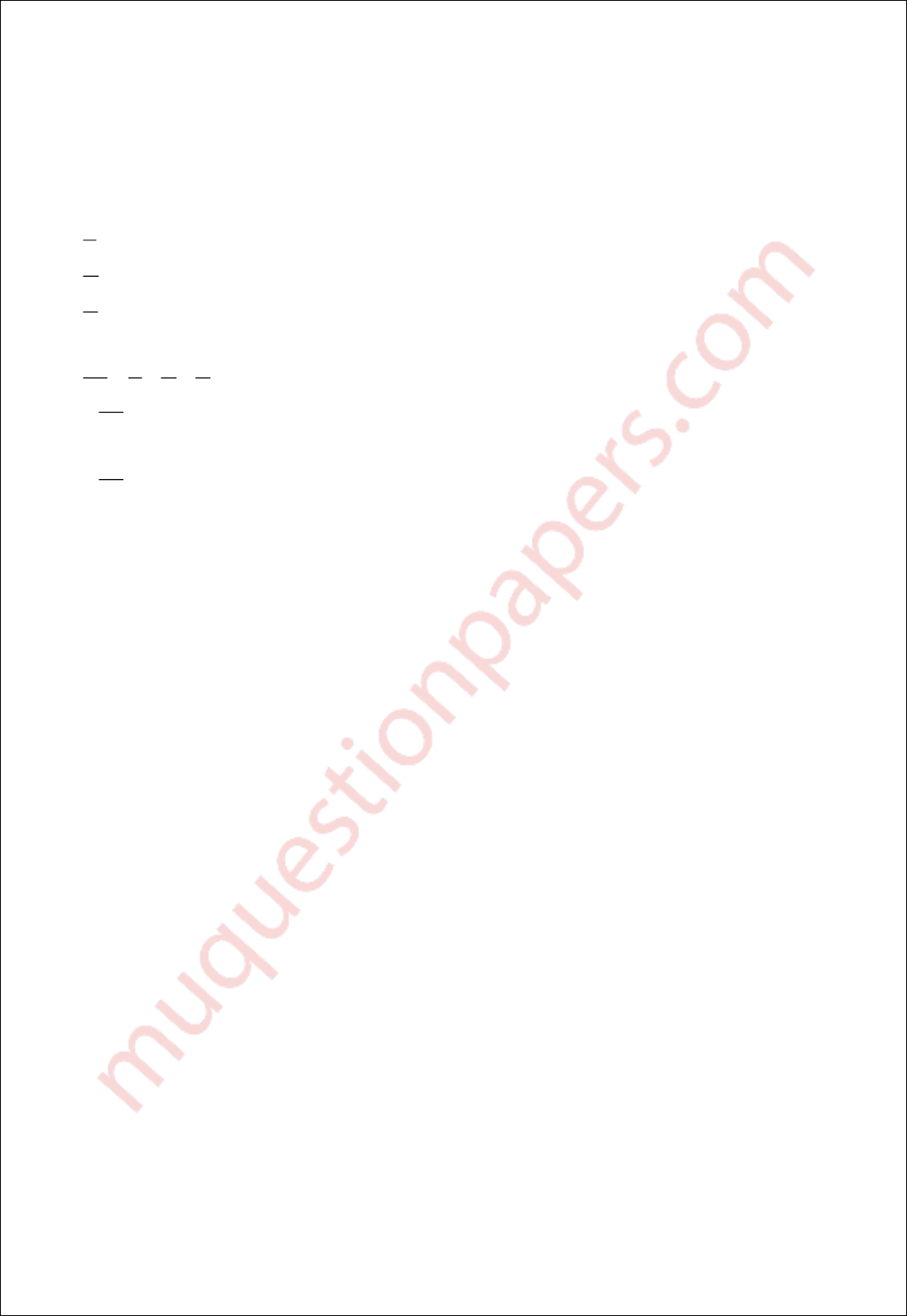
17
(b) Three forces
1 2 3
F,F and F
act at origin O.
1
F 70 N
acting along OA, where A (2, 1,
3).
2
F 80 N
acting along OB, where B(-1, 2, 0).
3
F 100 N
acting along OC, where
C(4, -1, 5). Find the resultant of these concurrent forces. (06 marks)
Solution:
1
2
3
net 1 2 3
net
net
F 70 2 3 N
F 80 2 N
F 100 4 5 N
F F F F N
F 70 2 3 80 2 100 4 5 N
F 460 130 710 N
i j k
ij
i j k
i j k i j i j k
i j k
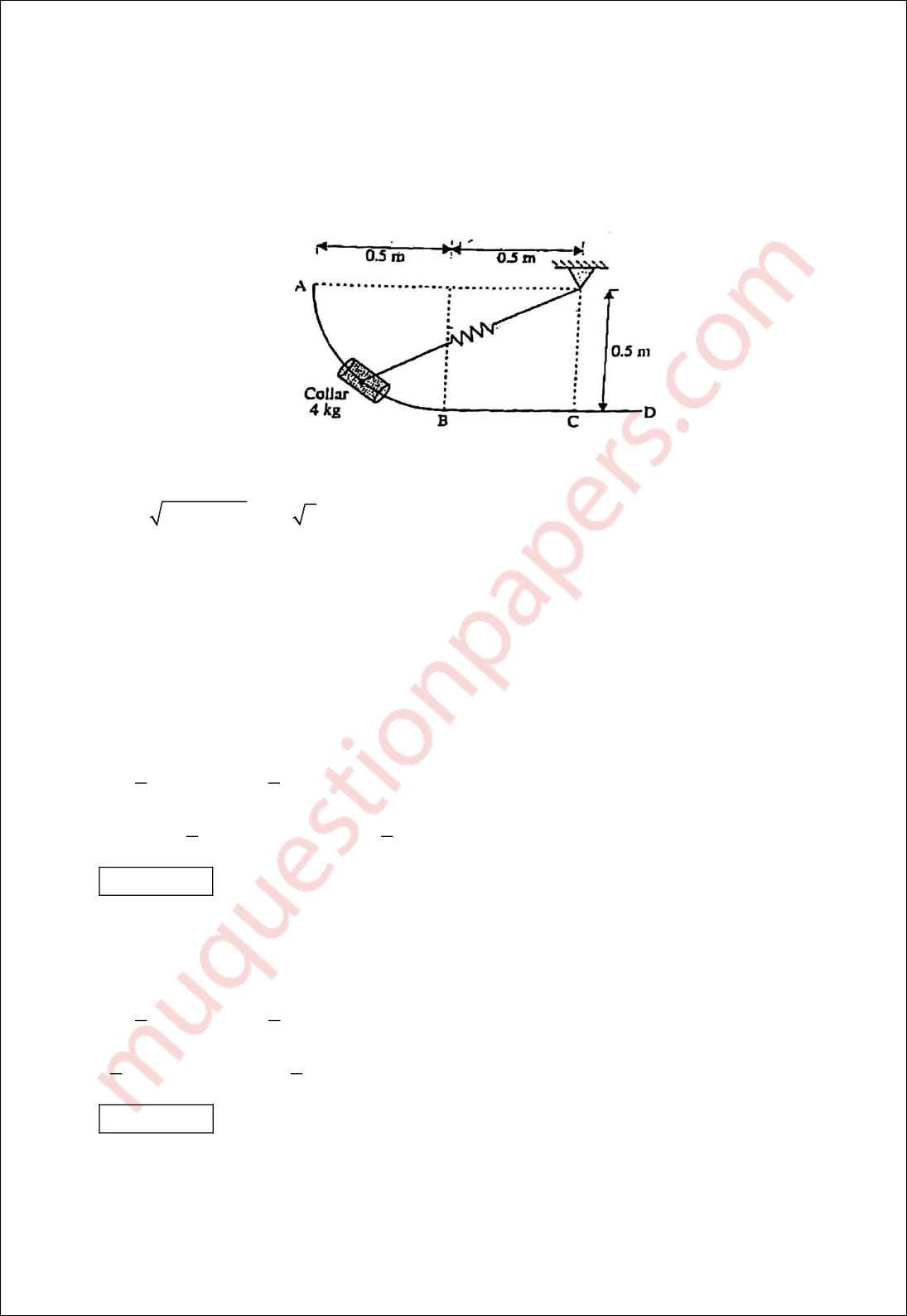
18
(c) A 4 kg collar is attached to a spring, slides on a smooth bent rod ABCD. The spring
has constant k=500 N/m and is undeformed when the collar is at ‘C’. If the collar is
released from rest at A. Determine the velocity of collar, when it passes through ‘B’ and
‘C’. Also find the distance moved by collar beyond ‘C’ before it comes to rest again.
Refer fig. (06 marks)
Solution:
22
( ) 0.5 0.5 0.5 2 0.707l OB
m
Natural Length (
0
l
) =0.5 m
A0
B0
OA 1 0.5 0.5 m
OB 0.707 0.5 0.207 m
xl
xl
Applying work energy theorem from A to B
2 2 2 2
2 2 2 2
2 2 2 2
2 2 2
Applying
.
work energy
W
2
theorem
8
fro
1
m
0
B
0
t
W
11
2
1
4(9. )(
o
0.5) (50 )( .5 0.207 ) (4)( 0 )
22
5.97 m/s
WW
11
22
11
0 (500)(0 (
4
C
2
,
.207 0 ) )( 5
2
g sp
A B B A
B
B
g sp
B C C B
C
K
mgh k x x m v v
v
v
K
mgh k x x m v v
v
2
97 )
6.40 m/s
C
v

19
2 2 2 2
2 2 2 2
0
2 2 2 2
WW
11
22
11
0 (500)(0 ) (4)(0 6.4 )
22
0.572 m
( ) 0.5 0.572 1.07 m
CD= 1.07 0.5 0.946 m
CD=0.946 m
Applying work energy theorem from C to D,
g sp
C D D C
D
D
D
K
mgh k x x m v v
x
x
l OD l x
OD OC
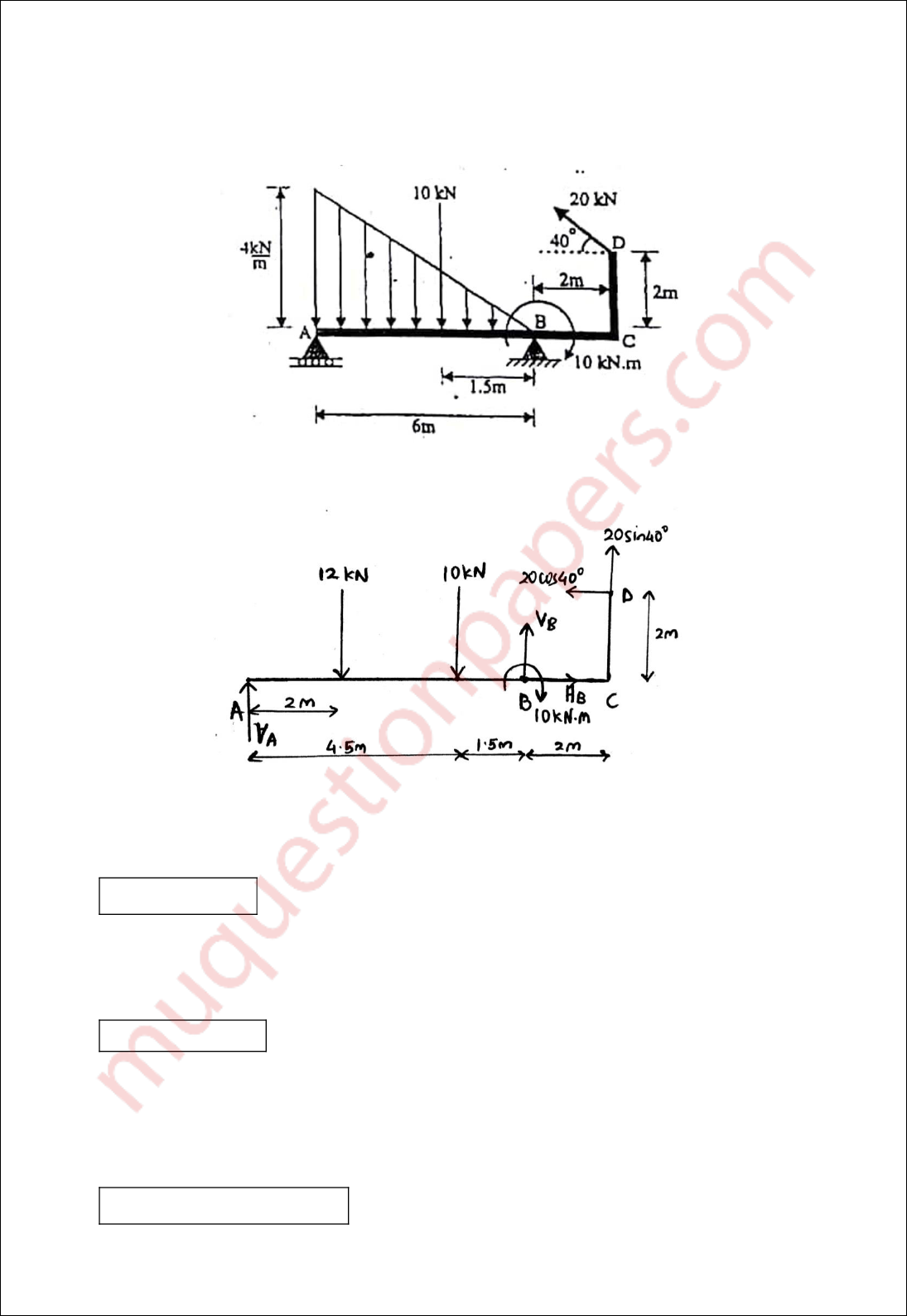
20
Q4. Attempt:
(a) Find the support reactions of beam loaded as shown in fig. (08 marks)
Solution: The FBD is,
B
A
A
X
B
B
Y
AB
B
B
M0
V (6) 12(4) 10(1.5) 20cos(40 )(2) 20sin(40 )(2) 0
V 19.89 kN
F0
H 20cos(40 ) 0
H 15.32 kN
F0
V 12 10 V 20sin(40 ) 0
19.89 12 10 V 20sin(40 ) 0
V 10.75 kN=10.75 kN

21
(b) Determine the moment to be applied at C for equilibrium of pin jointed mechanism.
Use virtual work method. Refer Fig. (06 marks)
Solution:
From line BD:
Active Forces
Coordinates
Virtual Displacement
H
F
3
5cosθ
V
F
0
0
For maintaining equilibrium,
By Principal of virtual work,
VH
H
V.W 0
F (0) F (5cosθ) 20=0
20 20
F 4secθ= kN
5cosθ3
Hence the moment to be applied at point C is
20
M= (3) 20 kNm
3
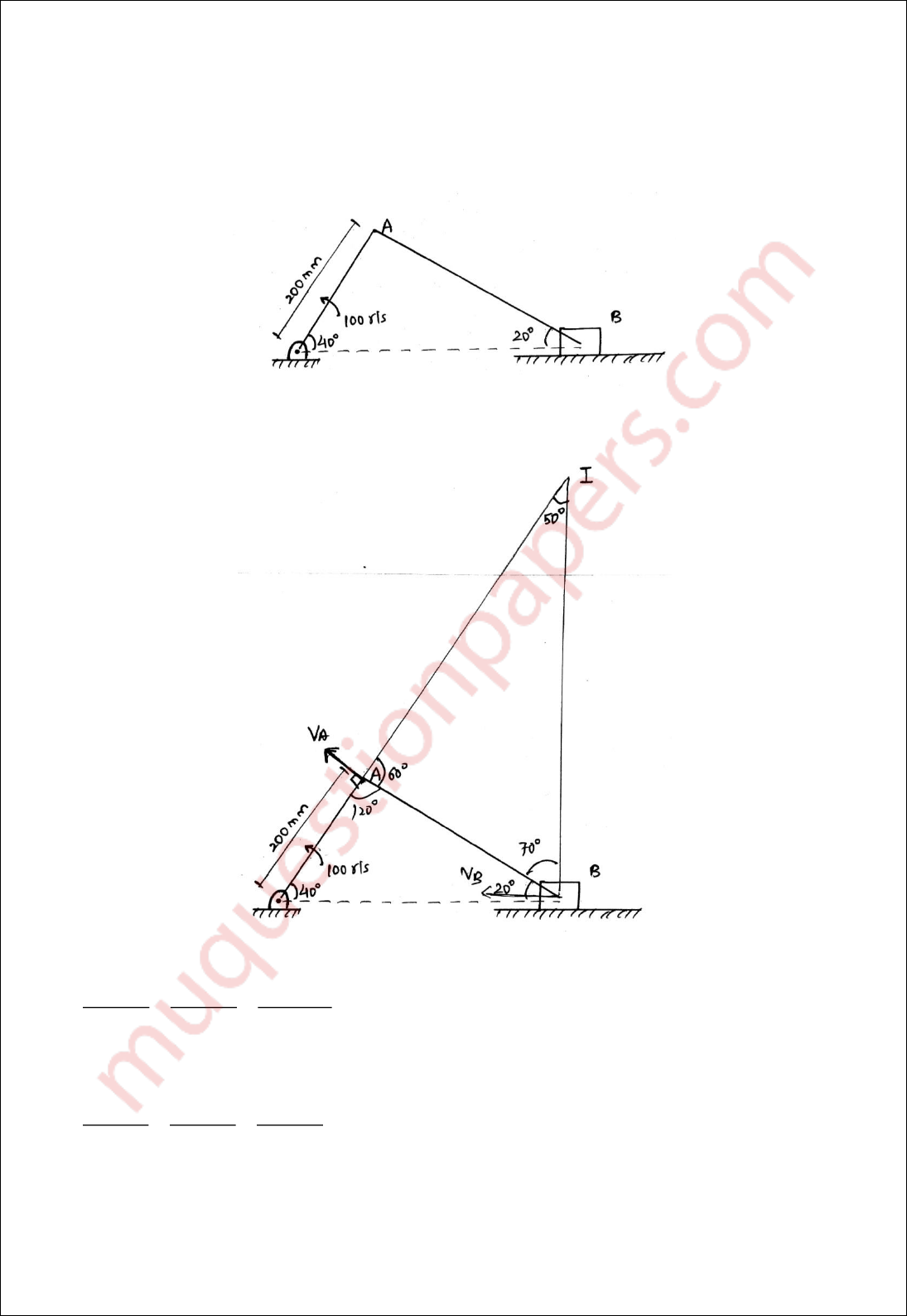
22
(c) A slider crank mechanism is shown in Fig. The crank OA rotates anticlockwise at
100 rad/s. Find the angular velocity of rod AB and the velocity of the slider at B.
(06 marks)
Solution: Finding ICR,
By sine rule,
200 AB OB
sin(20 ) sin(40 ) sin(120 )
AB=375.88 mm and OB=506.42 mm
By sine rule,
AB IA IB
sin(50 ) sin(70 ) sin(60 )
IA=461.09 mm and IB=424.94 mm

23
A OA
A
A
I
BI
I
B
V W .OA
200
V (100) 20 m/s
1000
V
20
W 43.48 rad/s
IA 0.46
V W IB=43.48(0.42)=18.26 m/s
W 43.48 rad/s
V 18.26 m/s
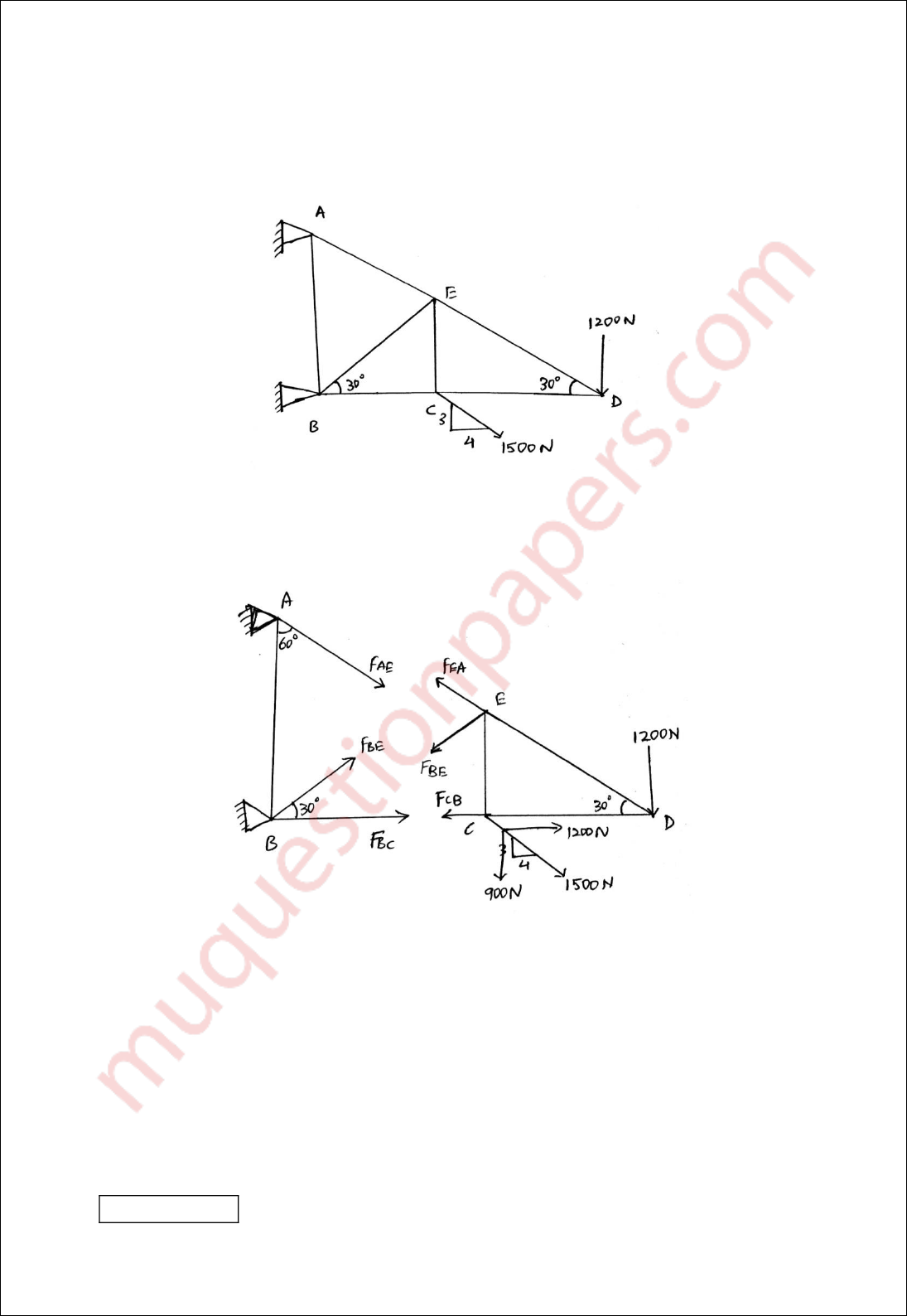
24
Q5. Attempt:
(a) Find the forces in the members BC, BE and AE by method of sections and remaining
members by method of joints. (08 marks)
Solution:
By method of section, cutting the given truss along AE, BE and BC
Consider the right part,
X
EA BC BE
Y
EA BE
F
E
BC
F0
F cos(30 ) F F sin(60 ) 1200 0 ....(1)
F0
F sin(30 ) F cos(60 ) 1200 900 0 ....(2)
Let the length of hypotenuse be
M0
F ( sin(30 )) 1200( sin(30 )) 1200( cos(30 )) 0
F
l
l l l
BC
878.46 N
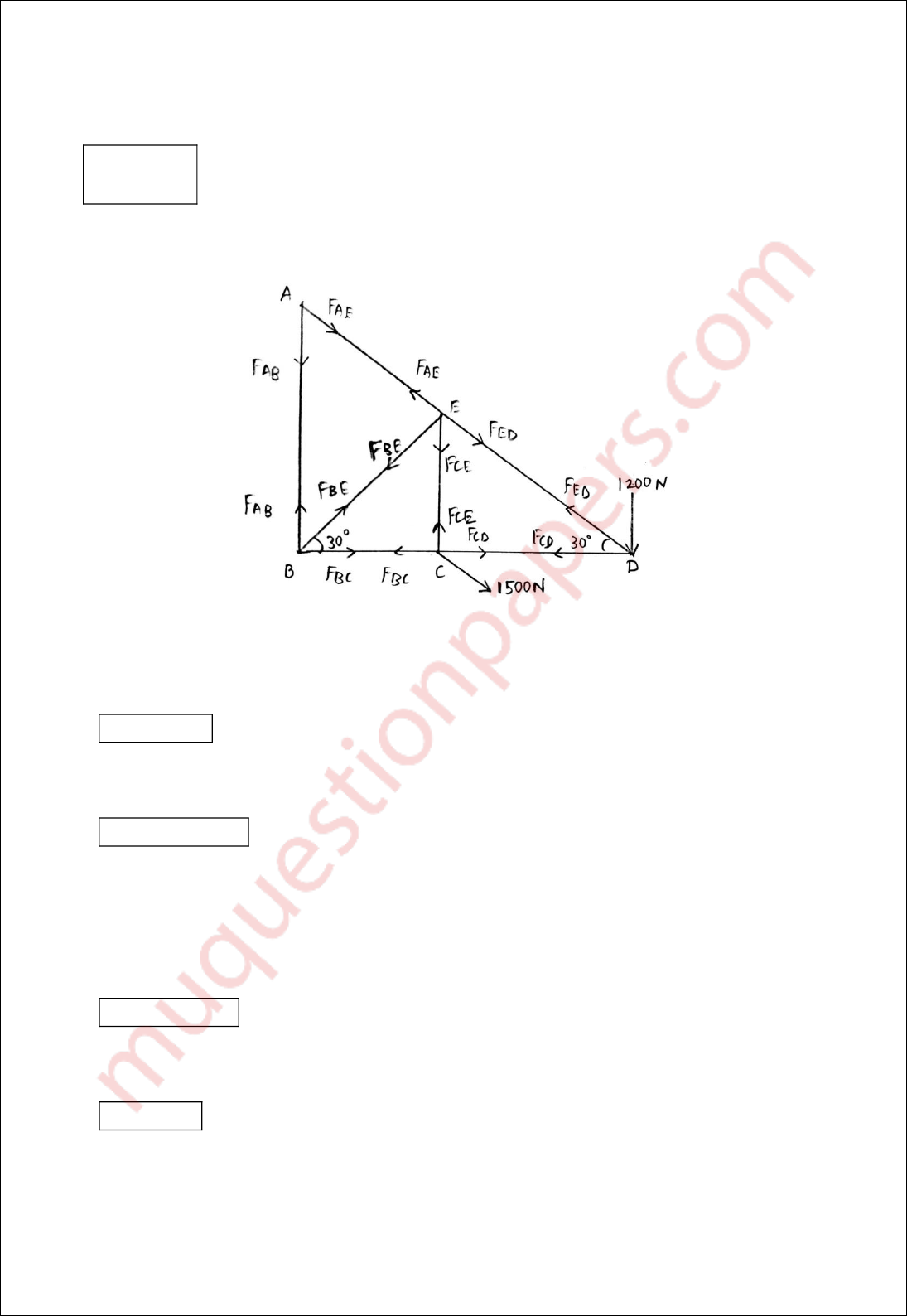
25
BC
EA BE
EA
BE
Put F in (1)
F cos(30 ) ( 878.46) F sin(60 ) 1200 0
F 3300 N
F 900 N
By method of joints,
Y
ED
ED
X
CD ED
CD
At point D
F0
1200 F sin(30 ) 0
F 2400 N
F0
F F cos(30 ) 0
F 2078.46 N
X
CD BC
BC
BC
Y
CE
CE
At point C
F0
F F 1200 0
2078.46 F 1200 0
F 878.46 N
F0
900 F 0
F 900 N
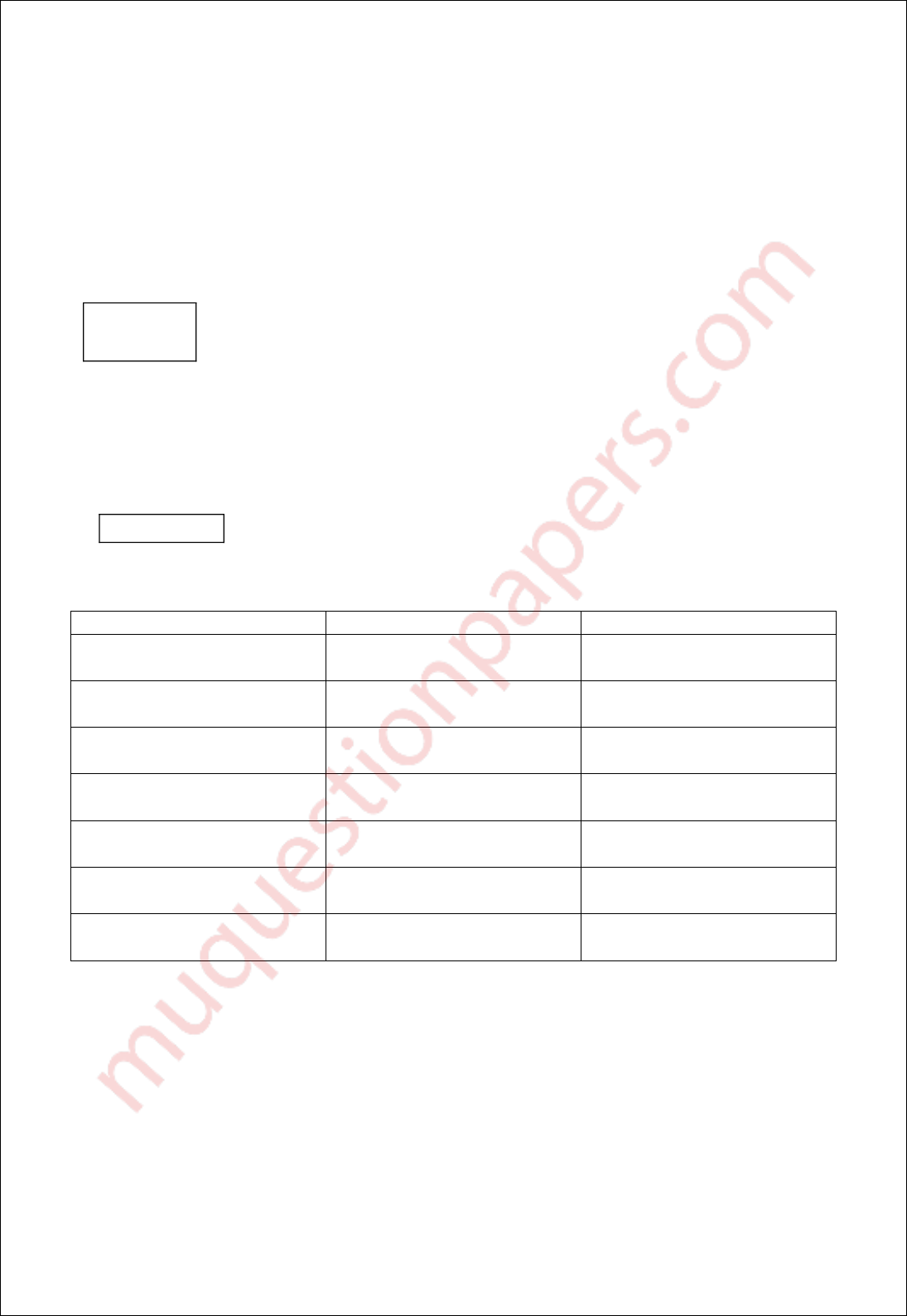
26
X
AE BE ED
AE BE
Y
AE BE CE ED
AE BE
AE
BE
At point E
F0
F cos(30 ) F sin(60 ) F cos(30 ) 0
F cos(30 ) F sin(60 ) 2400cos(30 ) 0
F0
F sin(30 ) F cos(60 ) F F sin(30 ) 0
F sin(30 ) F cos(60 ) 900 2400sin(30 ) 0
F 3300 N
F 90
0 N
Y
AB AE
AB
AB
At point A
F0
F F cos(60 ) 0
F 3300cos(60 )
F 1650 N
Member
Force Magnitude (in N)
Nature of Force
AB
1650
Compressive
BE
900
Tensile
BC
878.46
Compressive
AE
3300
Tensile
CE
900
Tensile
ED
2400
Tensile
CD
2078.46
Compressive
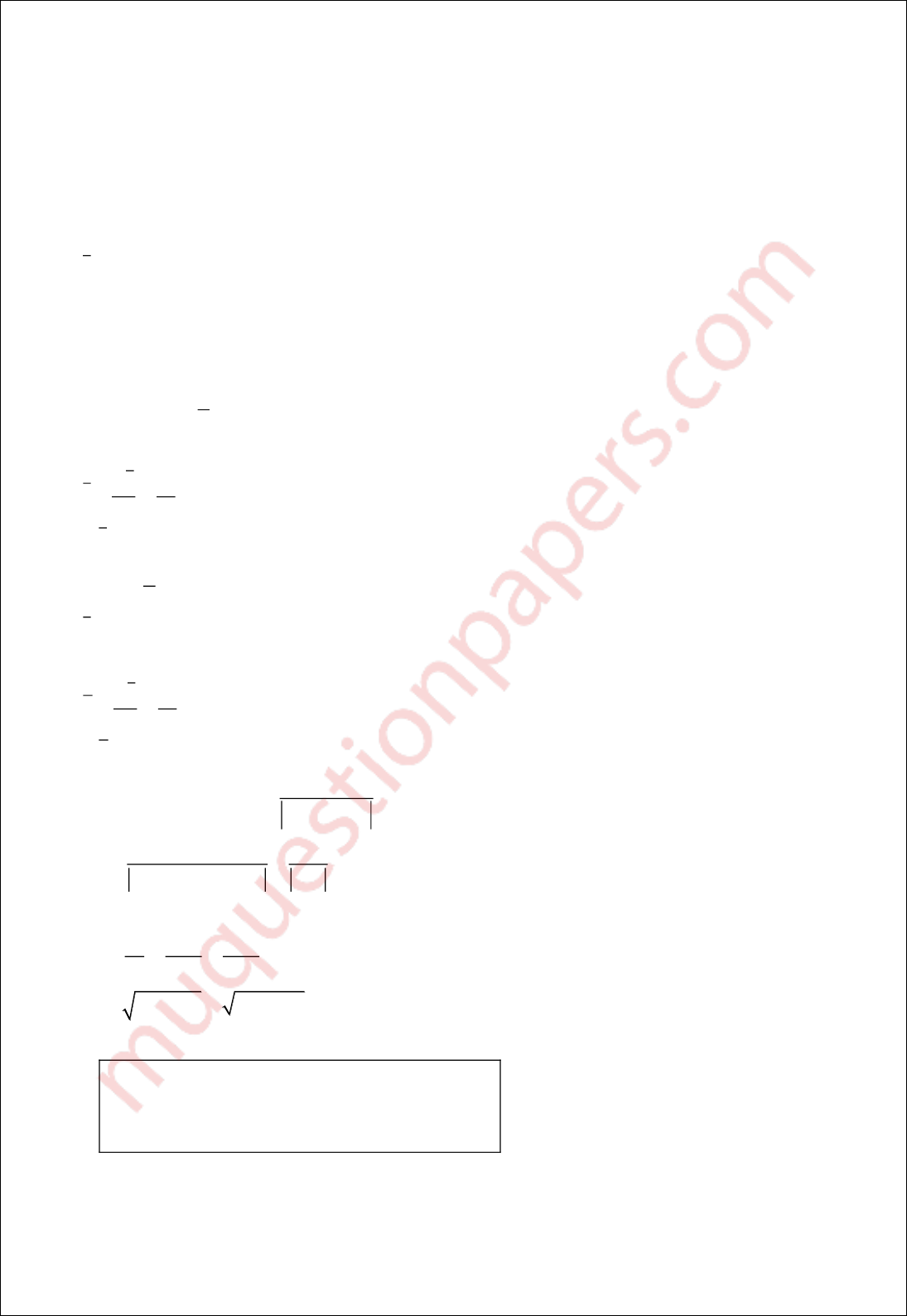
27
(b) A particle moves in x-y plane and it’s is given by
2
(3 ) (4 3 )r t i t t j
, where r is the
position vector of particle in metres at time t sec. Find the radius of curvature of the
path and normal and tangential components of acceleration when it crosses X-axis
region. (06 marks)
Solution:
2
(3 ) (4 3 ) mr t i t t j
When it crosses the x axis, the y coordinate is 0
2
2
2
2
3
3
(4 3 ) 0
4
0 or
3
(3 ) (4 3 )
3 (4 6 ) m/s
4
At t= ,
3
3 4 m/s=5 53.13 m/s
3 (4 6 ) m/s
6 m/s
Radius of curvature( )= m
5 12
=
(3)( 6) ( 4)(0)
x y y x
tt
t s t s
dr d
v t i t t j
dt dt
v i t j
s
v i j
dv d
a i t j
dt dt
aj
v
v a v a
22
2
2 2 2 2 2
2
2
5
a
Nor
a
ma
m
l
5
6
c
9
o
6.94
18
25
mn
3.6 m
4
/
pone t of
s
. 4 6.94
a 6 3
.6 4.8 m/
li
s
Radius of curv
3
ature=6.9
m
e
4
acce erat on= .6 /s and
Tangential component of acc leration= .8 m/
m n
s
d
N
TN
v
aa
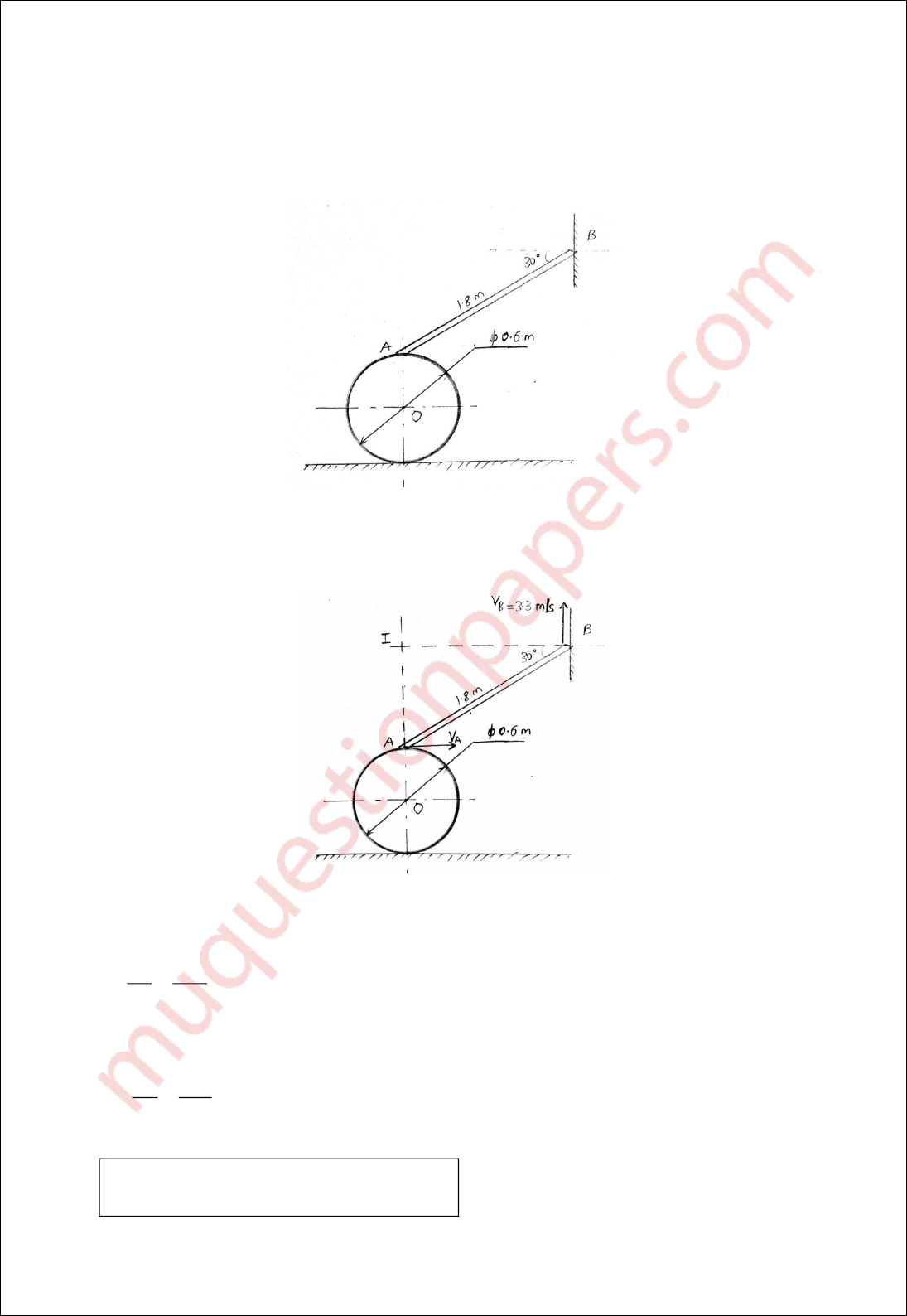
28
(c) C is a uniform cylinder to which a rod AB is pinned at A and the other end of the
rod is moving along a vertical wall as shown in fig. If the end B of the rod is moving
upwards along the wall with a speed of 3.3 m/s find the angular velocity of wheel and
rod assuming that cylinder is rolling without slipping. (06 marks)
Solution:
Locating the ICR,
B
B
I
AI
A
A
The angular velocity of wheel = and
the velocity of the ro
IB=1.8cos 30 =1.56 m and IA=1.8sin 30 0.9 m
V 3.3 m/s
V
3.3
W 2.12 r/s
IB 1.56
V W (IA)=(2.12)(0.9)
V 1.91 m/s
V
1.91
W= 6.37 r/s
R 0.3
6.37 r/s
1.91 = m/sd
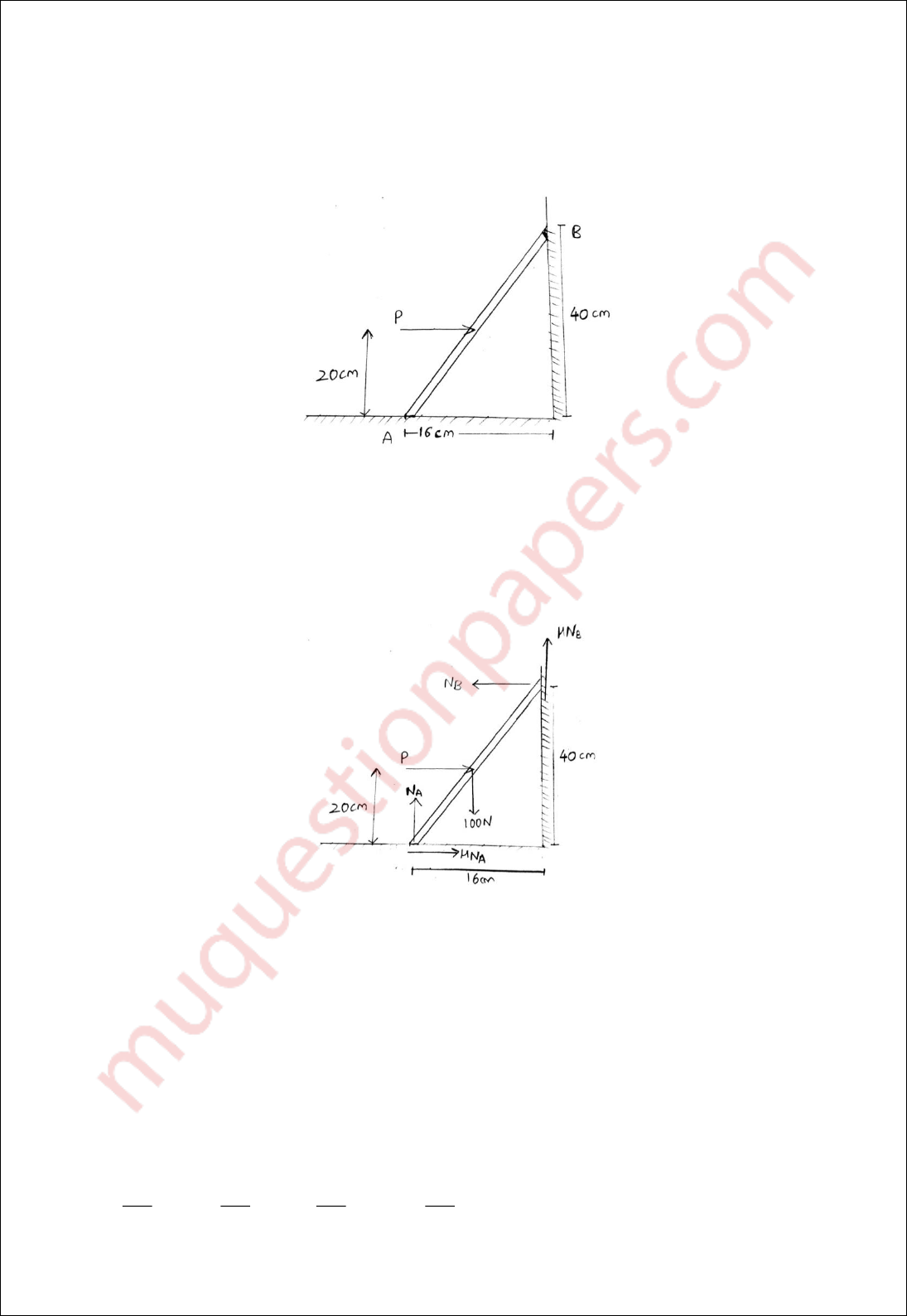
29
Q6.Attempt:
(a) A 100 N uniform rod AB is held in position as shown. If
0.15
at A and B
calculate range of value of P for which equilibrium is maintained. (08 marks)
Solution:
Let
AB
N and N
be the normal reactions at A and B respectively
For minimum value of P, FBD is,
x
AB
AB
y
AB
AB
A
BB
For equilibrium,
F0
N N P=0
0.15N N P=0 ...(1)
F0
N + N 100=0
N +0.15N +0P=100 ...(2)
M0
20 8 40 16
P 100 N N 0
100 100 100 100
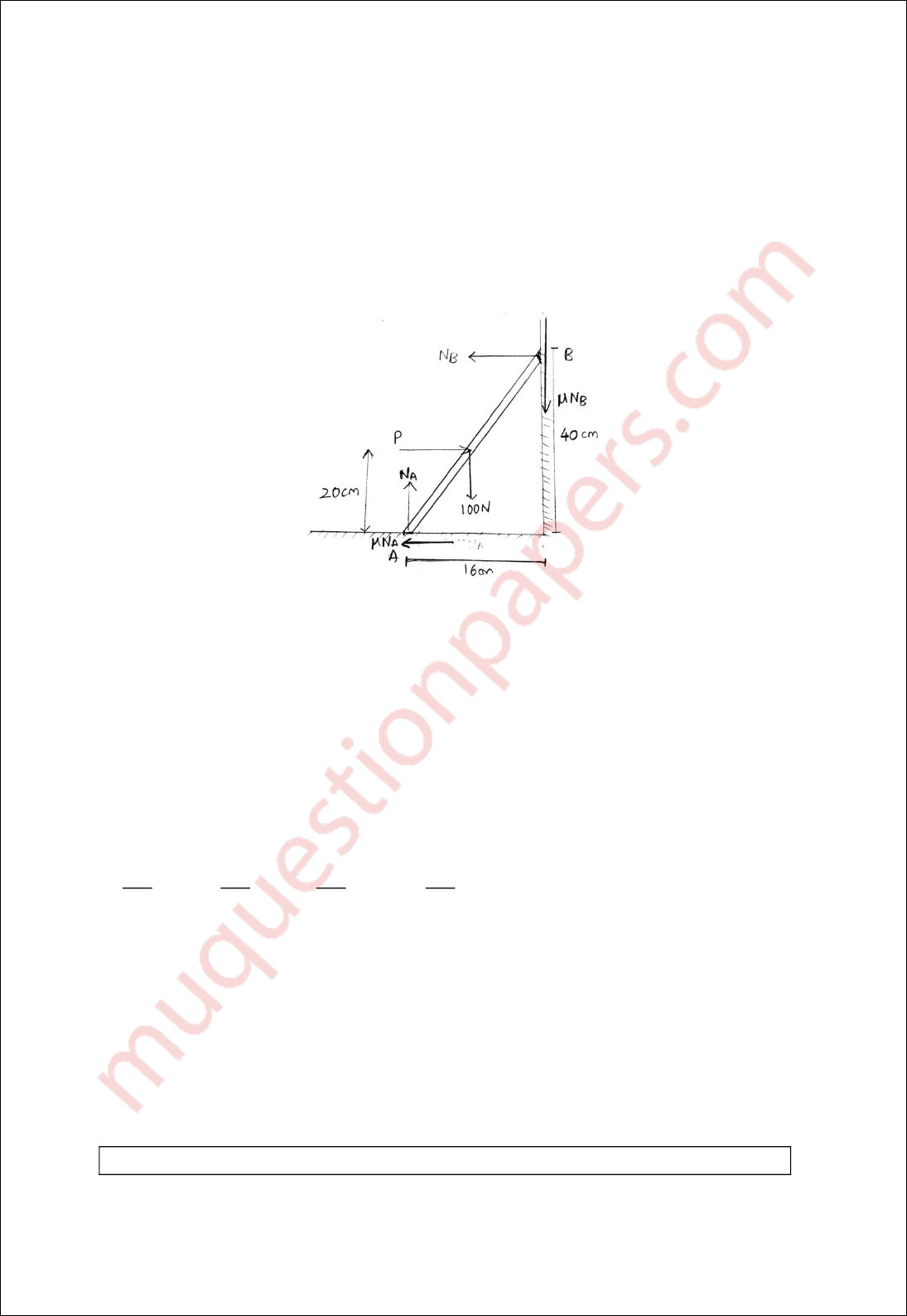
30
AB
0N 42.4N 20P= 800 ...(3)
A
A
From (1), (2) and (3),
N 96.58 N
N 22.78 N
P=8.29 N
For maximum value of P, FBD is,
x
AB
AB
y
AB
AB
A
BB
AB
For equilibrium,
F0
N N P=0
0.15N N P=0 ...(4)
F0
N N 100=0
N 0.15N +0P=100 ...(5)
M0
20 8 40 16
P 100 N N 0
100 100 100 100
0N 37.6N 20P= 800 ...(
6)
A
A
From (4), (5) and (6),
N 109.62 N
N 64.14 N
P=80.58 N
The range of value of P for which equilibrium is maintained is from 8.29 N to 80.58 N
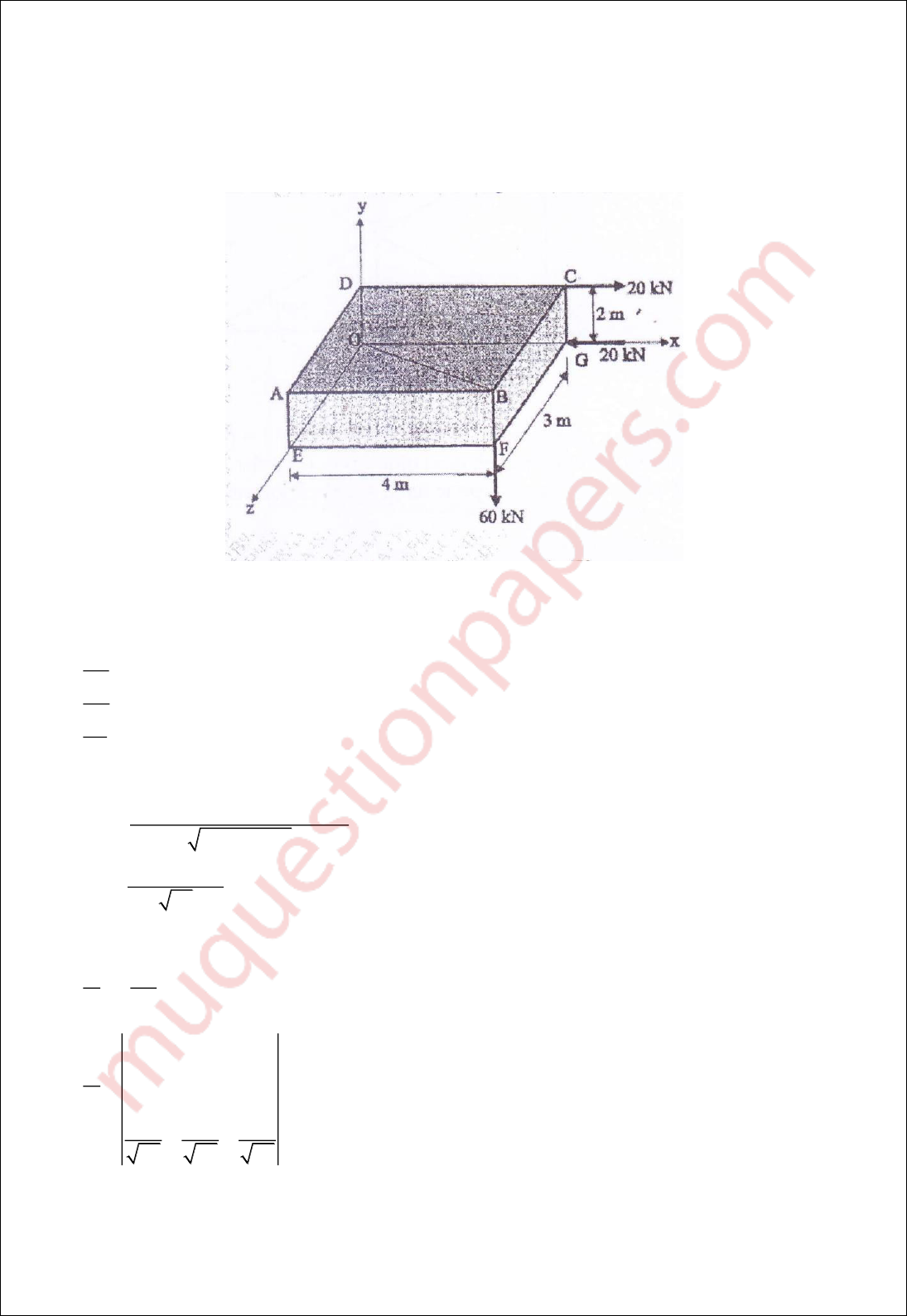
31
(b) A box of size
3 4 2 m
is subjected to three forces as shown in fig. Find in vector
form the sum of moments of the three forces about diagonal OB. (06 marks)
Solution:
The three forces are given as
DC
GO
BF
^
2 2 2
DC
^^
DC
ˆ
F 20 kN
ˆ
F 20 kN
ˆ
F 60 kN
The unit vector along the direction OB is
ˆ
ˆˆ
(4 0) (2 0) (3 0)
OB
4 2 3
ˆ
ˆˆ
4 2 3
=
29
The vector moment of force F along OB is
M OC F OB OB
4
M
i
i
j
i j k
i j k
^
20
20 0 0 OB
423
29 29 29
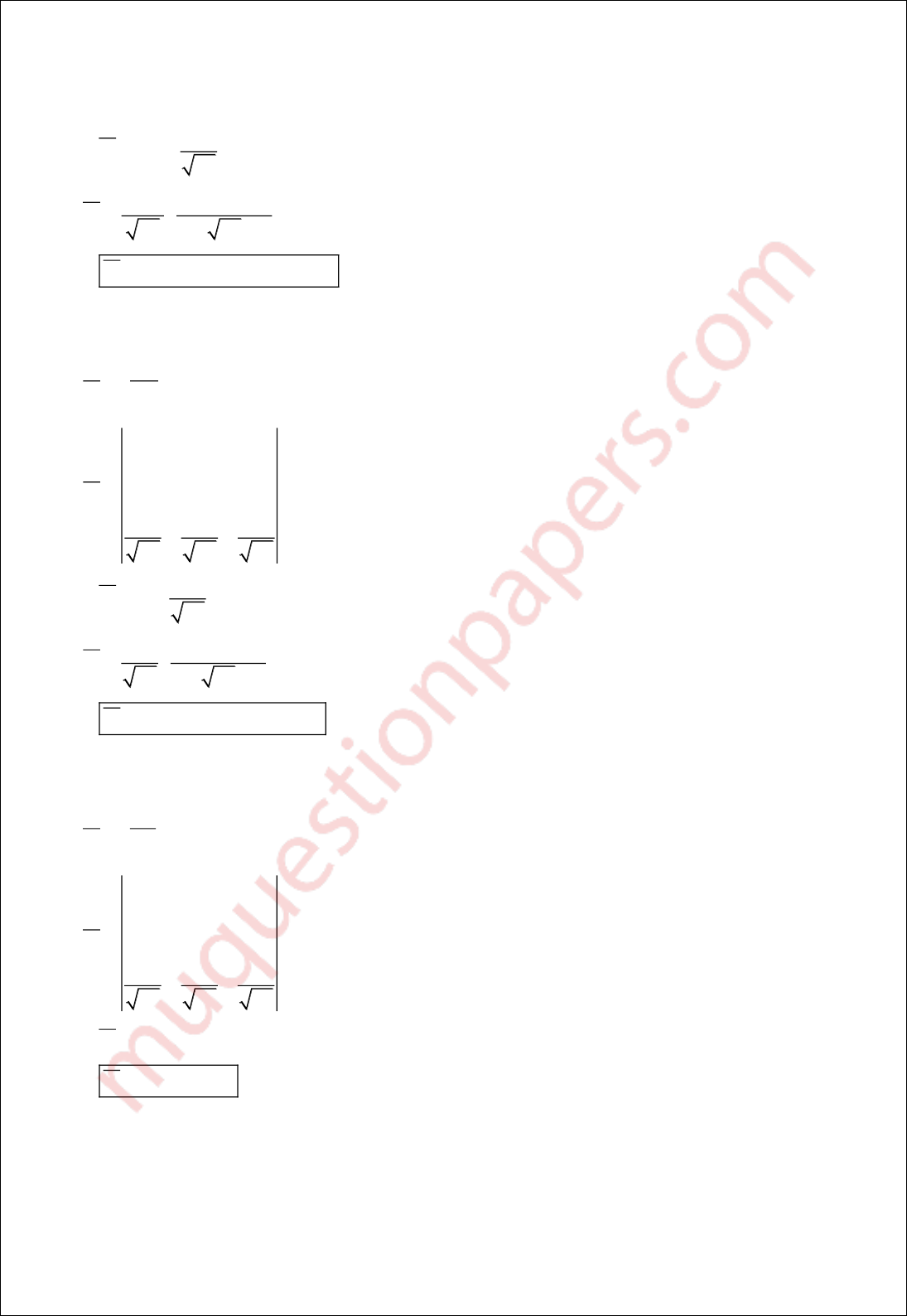
32
^
6
M 20 OB
29
ˆ
ˆˆ
120 4 2 3
M
29 29
ˆ
ˆˆ
M 16.55 8.28 12.41
i j k
i j k
GO
^^
GO
^
^
The vector moment of force F along OB is
M OG F OB OB
4 0 0
M 20 0 0 OB
423
29 29 29
6
M 20 OB
29
ˆ
ˆˆ
120 4 2 3
M
29 29
ˆ
ˆˆ
M 16.55 8.28 12.41
i j k
i j k
BF
^^
BF
^
^
The vector moment of force F along OB is
M OB F OB OB
423
M 20 0 0 OB
423
29 29 29
M 0OB .... Since 2 rows of the matrix are equal
ˆ
ˆˆ
M 0 0 0i j k
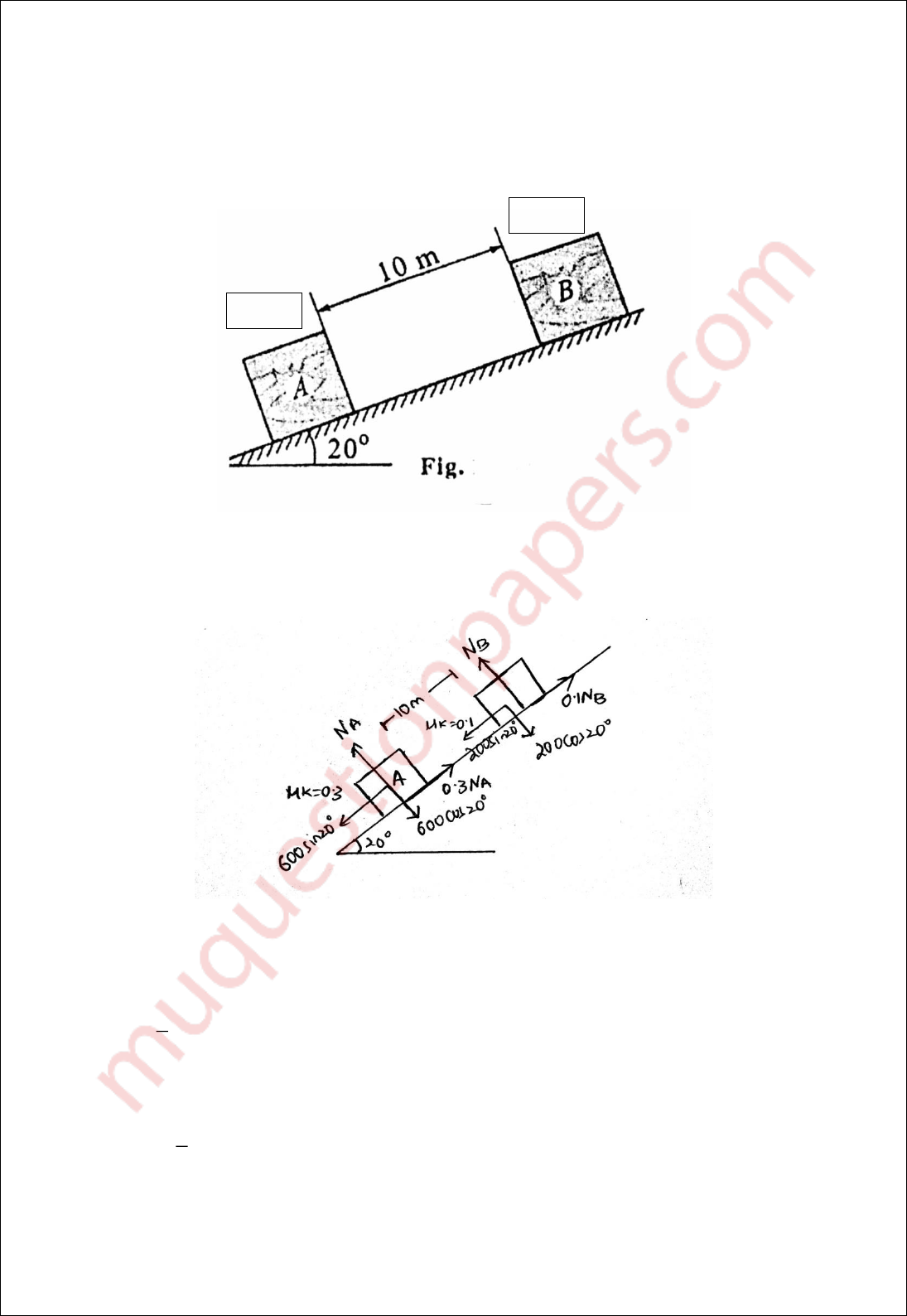
33
(c) Two blocks A and B are separated by 10 m as shown in fig on
20
incline plane. If
the blocks start moving, find the time t when the blocks collide and distance travelled by
each block. Assume
k
μ 0.3
for block A and block A and plane and
k
μ 0.10
for block
B and plane. (06 marks)
Solution:
The FBD is:
Let the time taken by the blocks to meet be t seconds
Let the distance travelled by block A be x m
2
1
0 .....(1), Acceleration of block A
2
AA
x a t a
Hence, distance travelled by block B is
2
1
10 0 .....(2), Acceleration of block B
2
BB
x a t a
600 N
200 N

34
From the FBD,
On block A,
A
A
AA
2
600 600
mass of block A= 61.22 kg
9.8
600cos(20 ) (N )
N 563.82 N
600sin(20 ) 0.3N
0.589 m/s
A
A
A
m
g
ma
a
On block B,
B
B
BB
2
200 200
mass of block B= 20.41 kg
9.8
200cos(20 ) (N )
N 187.94 N
200sin(20 ) 0.1N
2.43 m/s
B
B
B
m
g
ma
a
By putting the values of
A
a
and
B
a
in equations (1) and (2),
22
2
2
11
0.589 .....(3) and 10 2.43 .....(4)
22
Dividing equation (3) by (4),
1
0.589
2
1
10
2.43
2
3.2 m
From (3)
2(3.2)
t= 3.3 s
0.589
x t x t
t
x
x
t
x
The blocks collide after time=3.3 seconds and the distance travelled by block A is 3.2 m
and that by block B is (3.2+10) m=13.2 m.
